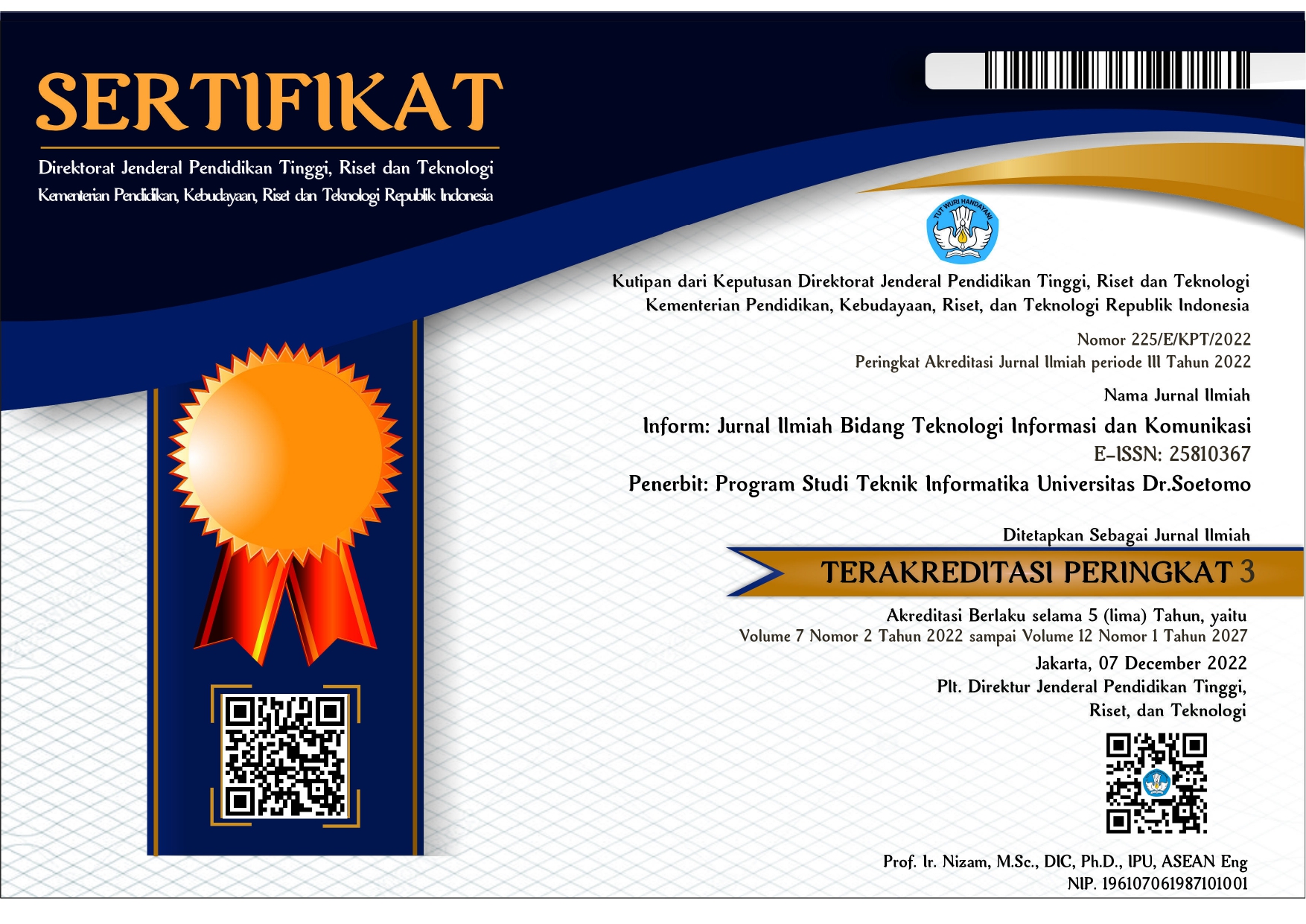Smart Greenhouse Coffee Dryer with Fuzzy Algorithm on Internet of Things Platform
 Abstract views: 338
,
Abstract views: 338
,
 PDF downloads: 298
PDF downloads: 298
Abstract
Coffee is a major commodity of the Indonesian plantation industry. One of Indonesia's lack of competitiveness in the international market is the low quality of coffee beans. This is because traditional farmers still use conventional methods for drying. The undried coffee cherries can damage the quality of coffee beans. Based on these problems, the researchers made a Smart Greenhouse dryer using the Internet of Things Platform. The Internet of Things is used to allow it to be monitored remotely in real-time. Temperature and humidity data in the greenhouse will be analyzed using a fuzzy algorithm. Actuators use the fuzzy output results to control the temperature and humidity of the greenhouse to reach the ideal drying conditions. The perfect drying temperature enables coffee cherries to achieve a moisture content of 12.55% within 14 days. Data on average temperature and humidity per day will be recorded and calculated to determine when the coffee cherries are ready for the next stage. The system can also calculate estimated days based on moisture content. With this, the drying of coffee cherries will be optimal and get the water content of the Indonesian National Standard to increase the quality and selling price of the coffee beans. The results show that Smart Greenhouse can be controlled remotely via the website. The integrated Sugeno Fuzzy algorithm keeps the greenhouse at the ideal drying temperature. Test results show that Smart Greenhouse can reduce the water content of coffee cherries 7.4 days more efficiently than conventional drying methods.
References
Direktorat Kajian Strategis dan kebijakan Pertanian, “Peran komoditas kopi bagi perekonomian Indonesia,” vol. 13, 2017.
R. Kustiari, “Perkembangan Pasar Kopi Dunia dan Implikasinya bagi Indonesia,” Forum Penelit. Agro Ekon., vol. 25, no. 1, p. 43, 2016, doi: 10.21082/fae.v25n1.2007.43-55.
P. Ghosh and N. Venkatachalapathy, "Processing and Drying of Coffee - A review," Int. J. Eng. Res. Technol., vol. 3, no. 12, pp. 784–794, 2014.
W. M. Kurniawan and K. Hastuti, “Penentuan Kualitas Biji Kopi Arabika Dengan Menggunakan Analytical Hierarchy Process (Studi Kasus Pada Perkebunan Kopi Lereng Gunung Kelir Jambu Semarang),” Simetris J. Tek. Mesin, Elektro dan Ilmu Komput., vol. 8, no. 2, p. 519, 2017, doi: 10.24176/simet.v8i2.1358.
A. Sulistyaningtyas, “Prosiding Seminar Nasional Publikasi Hasil-Hasil Penelitian dan Pengabdian Masyarakat ‘Implementasi Penelitian dan Pengabdian Masyarakat Untuk Peningkatan Kekayaan Intelektual’ PENTINGNYA PENGOLAHAN BASAH (WET PROCESSING) BUAH KOPI ROBUSTA (Coffea robusta,” Pentingnya Pengolah. basah (Wet Process. Buah kopi Robusta (Coffea var. robusta) untuk menurunkan resiko kecacatan biji hijau saat coffe grading, pp. 90–94, 2017.
W. Sutrisno, N. Amiralmahdi, and B. Wibowo, “Pembuatan Alat Penjemur Kopi,” Jattec, vol. 1, no. 2, pp. 100–103, 2020.
S. B. Prasetyo, N. Aini, and M. D. Maghfoer, “Dampak Perubahan Iklim Terhadap Produktivitas Kopi Robusta (Coffea Robusta) di Kabupaten Malang,” J. Produksi Tanam., vol. 5, no. 5, pp. 805–811, 2017.
F. Wijayanti and S. Hariani, “Pengaruh Pengeringan Biji Kopi dengan Metode Rumah Kaca dan Penyinaran Sinar Matahari Terhadap Kadar Air Biji Kopi Robusta (Coffea Robusta),” Pros. Semin. Nas. Sains Dan Teknol. Vol. 2. No. 1, 2019.
A. N. A. Syah, T. Nuryawati, and W. S. Litananda, “Pengembangan Smart Greenhouse Untuk Budidaya Holtikultura,” Semin. Nas. PERTETA 2018, no. 2010, pp. 1–10, 2018, [Online]. Available: http://www.ccw.ir/content/92/default.aspx.
L. K. Ramasamy and S. Kadry, "Internet of things (IoT)," Blockchain Ind. Internet Things, 2021, doi: 10.1088/978-0-7503-3663-5ch1.
Dodit Suprianto, Vipkas Al Hadid, Rini Agustina, Microcontroller Arduino Untuk Pemula, 1st ed. Jakarta: Jasakom, 2019.
D. Suprianto, N. Noprianto, and R. Agustina, "IoT DEVELOPMENT BOARD DSP-TECH," Internet of Things, 2021. https://iotboard.dsptech.info/internet-of-things/.
H. R. A. Ameer and H. M. Hasan, "Enhanced MQTT Protocol by Smart Gateway," Iraqi J. Comput. Commun. Control Syst. Eng., no. October, pp. 53–67, 2020, doi: 10.33103/uot.ijccce.20.1.6.
T. Yokotani, S. Ohno, H. Mukai, and K. Ishibashi, "IoT Platform with Distributed Brokerson MQTT," Int. J. Futur. Comput. Commun., vol. 10, no. 1, pp. 7–12, 2021, doi: 10.18178/ijfcc.2021.10.1.572.
D. Ismawati, D. Syauqy, and B. H. Prasetio, “Perbandingan Jumlah Membership Dan Model Fuzzy Terhadap Perubahan Suhu Pada Inkubator Penetas Telur,” J. Pengemb. Teknol. Inf. dan Ilmu Komput., vol. 1, no. 6, pp. 476–485, 2017, [Online]. Available: https://j-ptiik.ub.ac.id/index.php/j-ptiik/article/view/139.
A. Firdausi, I. R. F. Arif, and G. P. N. Hakim, "Time Control Nebulizer Operation Using Fuzzy Sugeno Method," J. Robot. Control, vol. 2, no. 2, 2021, doi: 10.18196/jrc.2259.
Copyright (c) 2022 Dodit Suprianto, Muhammad Taufik Prayitno, Luqman Affandi

This work is licensed under a Creative Commons Attribution-ShareAlike 4.0 International License.
Authors who publish with Inform: Jurnal Ilmiah Bidang Teknologi Informasi dan Komunikasi agree to the following terms:
-
Authors retain copyright and grant the journal right of first publication with the work simultaneously licensed under a Creative Commons Attribution License (CC BY-SA 4.0) that allows others to share the work with an acknowledgment of the work's authorship and initial publication in this journal.
-
Authors are able to enter into separate, additional contractual arrangements for the non-exclusive distribution of the journal's published version of the work (e.g., post it to an institutional repository or publish it in a book), with an acknowledgment of its initial publication in this journal.
-
Authors are permitted and encouraged to post their work online (e.g., in institutional repositories or on their website) prior to and during the submission process, as it can lead to productive exchanges, as well as earlier and greater citation of published work.













